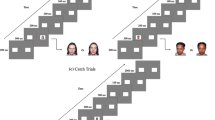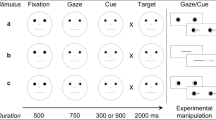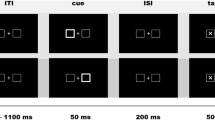Abstract
There has been renewed interest in the idea that attentional dysfunction may underlie autistic symptomatology (e.g., Bryson, Wainwright-Sharp, & Smith, 1990; Dawson & Lewy, 1989a, 1989b). Existing research indicates problems with overfocused attention (Lovaas et al., 1971; Rincover & Ducharme, 1987), and with shifting attention between sensory modalities (Courchesne et al., 1990). These phenomena were examined further by using Posner's (1978) visual orienting task with a group of high-functioning autistic adolescents and adults, and matched normal controls. Our results indicate that autistic people have difficulty processing briefly presented cue information. Evidence of problems disengaging and shifting attention within the visual modality was also provided. The findings can be seen as consistent with previous behavioral, autonomic, and electrophysiological research which has revealed impairments in the registration, processing, and response to external stimuli.
Similar content being viewed by others
References
Baynes, K., Holtzman, J. D., & Volpe, B. T. (1986). Components of visual attention: Alterations in response pattern to visual stimuli following parietal lobe infarction.Brain, 109, 99–114.
Bryson, S. E., Wainwright-Sharp, J. A., & Smith, I. M. (1990). Autism: A developmental spatial neglect syndrome? In J. Enns (Ed.),The development of attention: Research and theory (pp. 405–427). North Holland: Elsevier.
Ciesielski, K. T., Courchesne, E., & Elmasian, R. (1990). Effects of focused selective attention tasks on event-related potentials in autistic and normal individuals.Electroencephalography and Clinical Neurophysiology, 75, 207–220.
Courchesne, E. (1987). A neurophysiological view of autism. In E. Schopler & G. Mesibov (Eds.),Neurobiological issues in autism. New York: Plenum Press.
Courchesne, E., Akshoomoff, N. A., & Ciesielski, K. T. (1990).Shifting attention abnormalities in autism: ERP and performance evidence. Poster presented at the meeting of the International Neuropsychological Society, Orlando, FL.
Courchesne, E., Lincoln, A. J., Yeung-Courchesne, R., Elmasian, R., & Grillon, C. (1989). Pathophysiologic findings in nonretarded autism and receptive developmental language disorder.Journal of Autism and Developmental Disorders, 19, 1–17.
Dawson, G., & Lewy, A. (1989a). Arousal, attention, and the socioemotional impairments of individuals with autism. In G. Dawson (Ed.),Autism: Nature, diagnosis and treatment (pp. 49–74). New York: Guilford.
Dawson, G., & Lewy, A. (1989b). Reciprocal subcortical-cortical influences in autism. In G. Dawson (Ed.),Autism: Nature, diagnosis and treatment (pp. 144–173). New York: Guilford.
Dunn, L., & Dunn, L. M. (1981).The Peabody Picture Vocabulary Test-Revised. Circle Pines, MN: American Guidance Service.
Enns, J. T., & Brodeur, D. A. (1989). A developmental study of covert orienting to peripheral visual cues.Journal of Experimental Child Psychology, 48, 171–189.
Eskes, G. A., Bryson, S. E., & McCormick, T. A. (1990). Comprehension of concrete and abstract words in autistic children.Journal of Autism and Developmental Disorders, 20, 61–73.
Garretson, J. B., Fein, D. & Waterhouse, L. (1990). Sustained attention in children with autism.Journal of Autism and Developmental Disorders, 20 101–114.
Heilman, K. M., Watson, R., & Valenstein, E. (1979). Neglect and related disorders. In K. M. Heilman & E. Valenstein (Eds.),Clinical neuropsychology (pp. 243–293) New York: Oxford University Press.
Hermelin, B. & O'Connor, N. (1970).Psychological experiments with autistic children. Oxford, U.K.: Pergamon.
Hutt, C., Hutt, S. J., Lee, D., & Ounsted, C. (1964). Arousal and childhood autism.Nature, 204, 908–909.
James, A., & Barry, R. (1980). A review of psychophysiology in early onset psychosis.Schizophrenia Bulletin, 6, 506–525.
Jonides, J. (1981). Voluntary versus automatic control over the mind's eye's movement. In J. Long & A. Baddeley (Eds.),Attention and performance IX (pp. 187–203). Hillsdale, NJ: Erlbaum.
Jonides, J., & Mack, R. (1984). On the cost and benefit of cost and benefit.Psychological Bulletin, 96, 29–44.
Kinsbourne, M. (1987). Cerebral-brainstem relations in infantile autism. In E. Schopler & G. Mesibov (Eds.),Neurobiological issues in autism (pp. 107–125). New York: Plenum Press.
Landry, S. H., Schmidt, M., & Richardson, M. A. (1990). Joint attention of six-month-old Down syndrome and preterm infants: I. Attention to toys and mothers.American Journal on Mental Retardation, 94, 488–498.
Lovaas, O. I., Schreibman, L., Koegal, R., & Rehm, R. (1971). Selective responding by autistic children to multiple sensory input.Journal of Abnormal Psychology, 77, 211–222.
Ornitz, E. M., & Ritvo, E. R. (1968). Perceptual inconstancy in early infantile autism.Archives of General Psychiatry, 18, 76–98.
Ozonoff, S., Rogers, S. J., & Pennington, B. F. (1991). Asperger's syndrome: Evidence of an empirical distinction from high-functioning autism.Journal of Child Psychology and Psychiatry, 32, 1107–1122.
Posner, M. I. (1978).Chronometric explorations of the mind. Hillsdale, NJ: Erlbaum.
Posner, M. I. (1980). Orienting of attention.Quarterly Journal of Experimental Psychology, 32, 3–25.
Posner, M. I., Early, T. S., Reiman, E., Pardo, P. J. & Dhawan, M. (1988). Asymmetries in hemispheric control of attention in schizophrenia.Archives of General Psychiatry, 45, 814–821.
Poster, M. I., Walker, J. A., Friedrich, F. J., & Rafal, R. D. (1984). Effects of parietal injury on covert orienting of attention.Journal of Neuroscience, 4, 1863–1874.
Rimland, B. (1964).Infantile autism. New York: Appleton-Century-Crofts.
Rincover, A., & Ducharme, J. M. (1986). Variables influencing stimulus overselectivity and “tunnel vision” in developmentally delayed children.American Journal of Mental Deficiency, 91, 422–430.
Stevens, S. & Gruzelier, J. (1984). Electrodermal activity to auditory stimuli in autistic, retarded, and normal children.Journal of Autism and Developmental Disorders, 14, 245–260.
Tager-Flusberg, H. (1986). Constraints on the representation of word meaning: Evidence from autistic and mentally retarded children. In M. Barrett & S. A. Kuczaj (Eds.),The development of word meaning (pp. 69–81). New York: Springer-Verlag.
van Engeland, H. (1984). The electrodermal orienting response to auditive stimuli in autistic children, normal children, mentally retarded children, and child psychiatric patients.Journal of Autism and Developmental Disorders, 14, 261–279.
Zhan, T. P., Rumsey, J. M. & Van Kammer, D. P. (1987). Autonomic nervous system activity in autistic, schizophrenic, and normal men: Effects of stimulus significance.Journal of Abnormal Psychology, 96, 135–144.
Author information
Authors and Affiliations
Additional information
This research was conducted in partial fulfillment of the first author's masters thesis. The work was supported by a Natural Science and Engineering Research Council grant awarded to Susan Bryson. We are grateful to the residents and staff of Woodview Manor, Hamilton, Ontario, and Kerry's Place, Aurora, Ontario, for their participation in this research.
Rights and permissions
About this article
Cite this article
Wainwright-Sharp, J.A., Bryson, S.E. Visual orienting deficits in high-functioning people with autism. J Autism Dev Disord 23, 1–13 (1993). https://doi.org/10.1007/BF01066415
Issue Date:
DOI: https://doi.org/10.1007/BF01066415




